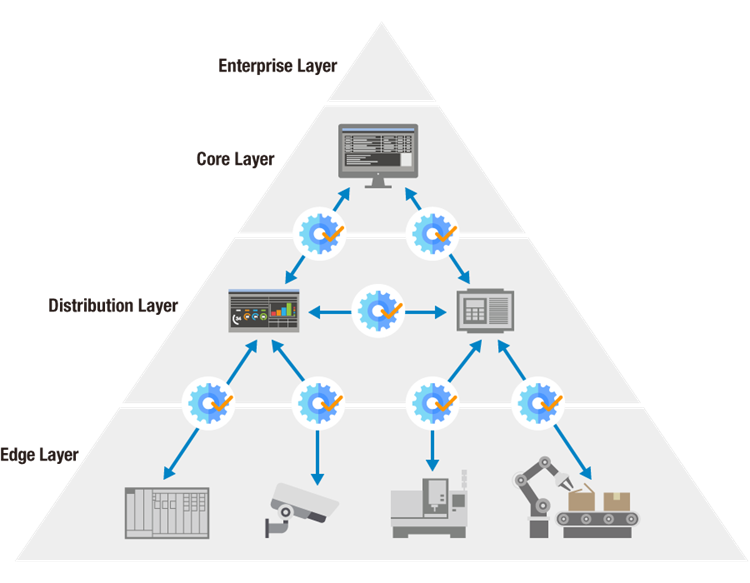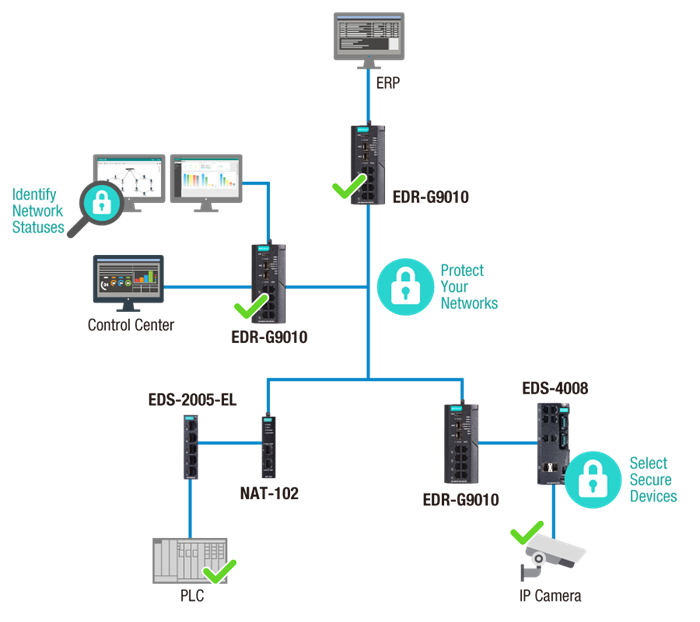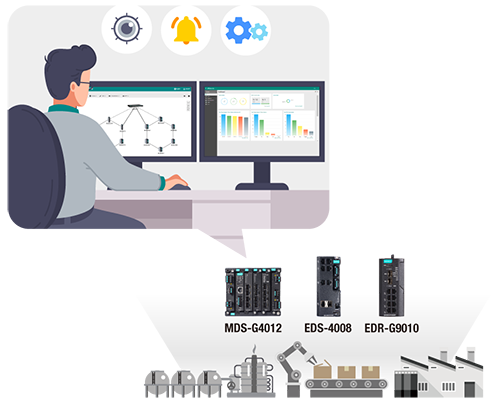The modern business landscape requires a shift in how they engage, respond, and cater to their clientele in order to seize fresh revenue streams and opportunities that generate value. Digitalization plays a pivotal role in industrial applications, facilitating enhancements across two distinct innovation paradigms:
- Innovation in Operational Models: Enhancing operational efficiency and productivity through minimizing machine/asset downtime, optimizing asset utilization rates, etc. For instance, utilizing real-time machine monitoring to gain better insights into machine capabilities, fostering enhancements in production efficiency, and improving maintenance scheduling.
- Innovation in Business Models: Augmenting competitive advantages and value creation by fundamentally transforming how a company delivers value to its customers. For example, certain OEM machine manufacturers transitioned their business model from one-time machine sales to a machine-as-a-service model, generating recurring revenue streams throughout a machine’s lifespan.
Irrespective of the strategic approach your organization adopts, the convergence of IT and OT is indispensable for achieving its triumph. By amalgamating IT and OT systems, businesses can fully exploit their dispersed yet valuable data to optimize their technological prowess and revolutionize their operations.
Digitalization introduces heightened network intricacies, underlining the importance of establishing a unified network to augment efficiency, system reliability, and simplify maintenance. Consolidating disparate industrial Ethernet protocols utilized by different devices and equipment by implementing new technologies such as TSN is imperative to forge a singular unified network. This evolution demands both time and resources, but businesses must concurrently address immediate requirements. Consequently, we advocate for businesses to embark on a step-by-step digitalization journey, focusing on incremental enhancements that are also future-ready.
This article is crafted to furnish practical guidance on streamlining industrial communication networks while safeguarding your investments to be poised for reaping tomorrow’s benefits.
Prepare for the Future Networking Demands of Your Enterprise
-
Simplify Edge-to-Core Solutions for Enhanced Data Connectivity Support
The burgeoning realm of IT/OT converged applications is ushering in a plethora of sensors and machines within industrial networks, leading to the escalating need for transmitting and exchanging copious amounts of data. For instance, the proliferation of AI applications integrated with machine vision can elevate quality inspection, worker safety detection, and facility security. This surge has led to a widespread adoption of IP cameras in industrial setups. While high-resolution cameras can boost performance and accuracy, they also generate larger file sizes and video streams necessitating enhanced bandwidth and network performance. These complexities underscore the requirement for an increasing array of networking devices that are tedious to incorporate into already teeming control cabinets, escalating the burden on field engineers. Hence, there is a growing importance on network solutions offering seamless integration.
In such scenarios, ensuring streamlined communication in converged networks mandates companies to anticipate their imminent operational requirements and incorporate requisite flexibility to cater to future demands. We recommend opting for solutions featuring a compact form factor compatible with control cabinets, and a modular design enabling the addition of connectivity and capabilities as needs expand. Endowing edge layer support for various industrial protocols facilitates seamless interoperability and integration with SCADA/HMI systems, enhancing operational performance and adaptability. Ensuring bandwidth and performance at the distribution and core layer is crucial for optimizing Edge-to-Core data connectivity. Moxa furnishes a dependable network bedrock facilitating smooth data transmission and seamless integration, enabling the establishment of future-ready networks spanning from the edge to the core.

-
Address Rising Network Security Risks with Layered Protection
The synergy between IT and OT networks coincides with the swift adoption of IIoT technology across both domains, enlarging the overall attack surface and diversifying attack vectors. The burgeoning cybersecurity threats have instigated reports of operational disruptions in industrial control systems and critical infrastructures due to insufficient OT network security, resulting in unauthorized alterations or configurations. Historically, OT devices were isolated from other networks through air-gapping; however, IT/OT convergence has dissolved this boundary, exposing OT infrastructure to cyber perils. Administrators grapple with managing prevailing vulnerabilities concealed within erstwhile isolated OT networks, compounded by emerging IT-related threats. Amidst bolstering network security for OT networks, prioritizing reliable, uninterrupted operational efficiency is paramount.
To fortify industrial network security and instate a robust network cornerstone, the primary focus should be on secure networking with defense-in-depth measures. Commencing with the selection of security-hardened devices complying with industrial security benchmarks like IEC 62443 and NERC CIP, additional layers of protection are vital to repel attacks through practices such as essential network segmentation and preemptive threat mitigation. An essential monitoring framework is imperative to detect and counter cyber threats promptly. Moxa offers comprehensive network security tailored to industrial network exigencies by integrating three layers of defense-in-depth protection, empowering businesses to ensure both network security and availability during the transition to a converged infrastructure.

-
Simplify Network Management to Oversee Expanding Networks with Ease
As IT and OT networks amalgamate, network intricacies surge, magnifying the necessity for proficient network management to sustain uninterrupted, efficient network operations. A single failure point could detrimentally impact the entire OT infrastructure and even IT networking systems, potentially inducing costly downtime. Service providers necessitate a network management tool providing comprehensive network oversight at customer sites, streamlining troubleshooting,and facilitates remote upkeep.
Ideally, an OT network management tool should possess the following capabilities:
- Network Observability: This stands out as the most crucial aspect, while also being the most elementary factor. Additional beneficial functionalities may include monitoring performance, traffic congestion, and security condition of network gadgets.
- Rapid Troubleshooting: This involves the capability to identify service outages and isolate the main cause of problems to minimize disruptions to operations. Configurable event alerts can assist organizations in promptly resolving issues, at times even before any incidents arise.
- Simplified Upkeep: This encompasses the option to remotely back up or restore gadget configurations and update firmware for devices across a deployment, all managed from a centralized position. This empowers administrators to carry out upgrades and maintenance tasks without dispatching engineers for individual device maintenance on-site, which can be particularly challenging if devices are situated in control enclosures or within machinery.
Effective network management tools empower you to boost network efficiency and uptime, detect issues and respond swiftly to them, and streamline future expansion efforts. Moxa provides OT-oriented network management solutions that are user-friendly and tailored to meet the requirements of OT engineers, thus reducing the challenges associated with managing the escalating network complexity. These solutions can even enable businesses to deliver enhanced post-sale services and explore new business models such as machine-as-a-service.


Utilize Futureproof Network Infrastructure to Ensure the Success of Your Digital Transformation Endeavor
While striving to integrate your IT and OT networks in the course of digital transformation, your network infrastructure must adapt to meet the impending demands. An esteemed figure in industrial networking, Moxa pledges to aid businesses in transitioning to the next era of industrial networking by catering to the demands of their varied applications and assisting them in effectively establishing futureproof industrial network infrastructure to accomplish their innovation objectives.
To delve deeper into the implementation of our futureproof network infrastructure in diverse applications, delve into these application notes:
- Not Only for Automobiles: Discovering CANbus Technology in Various Industrial Settings - October 29, 2024
- Boost Your Network Performance: An Exciting Manual to PoE Switches! - September 10, 2024
- Understanding Gigabit Switches: Industrial vs Regular Gigabit - September 4, 2024


